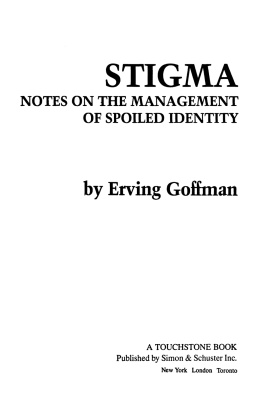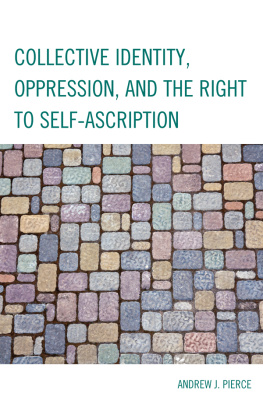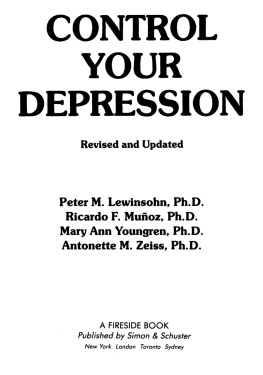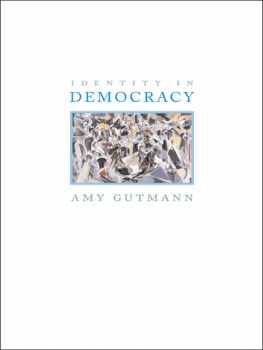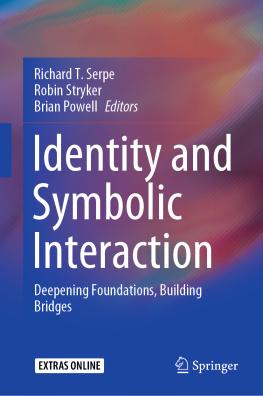Thank you for purchasing this A Touchstone Book.
Sign up for our newsletter and receive special offers, access to bonus content, and info on the latest new releases and other great eBooks from A Touchstone Book.

or visit us online to sign up at
eBookNews.SimonandSchuster.com

Copyright 1963 by Simon & Schuster, Inc.
All rights reserved
including the right of reproduction
in whole or in part in any form
First Touchstone Edition, 1986
Published by Simon & Schuster, Inc.
Rockefeller Center
1230 Avenue of the Americas
New York, New York 10020
www.SimonandSchuster.com
Originally published by Prentice-Hall, Inc.
TOUCHSTONE and colophon are registered trademarks of
Simon & Schuster, Inc.
Library of Congress Cataloging-in-Publication Data
Goffman, Erving.
Stigma: notes on the management of spoiled identity.
Includes bibliographical references.
1. Stigma (Social psychology) 2. Identity (Psychology)
I. Title.
HM291.G624 1986 155.2 84-46153
ISBN 0-671-62244-7 Pbk.
ISBN: 978-0-6716-2244-2 (print)
ISBN: 978-1-4391-8833-0 (ebook)
PREFACE
For over a decade now in the literature of social psychology there has been good work done on stigmathe situation of the individual who is disqualified from full social acceptance.
In this essay
CONTENTS
Dear Miss Lonelyhearts
I am sixteen years old now and I dont know what to do and would appreciate it if you could tell me what to do. When I was a little girl it was not so bad because I got used to the kids on the block makeing fun of me, but now I would like to have boy friends like the other girls and go out on Saturday nites, but no boy will take me because I was born without a nosealthough I am a good dancer and have a nice shape and my father buys me pretty clothes.
I sit and look at myself all day and cry. I have a big hole in the middle of my face that scares people even myself so I cant blame the boys for not wanting to take me out. My mother loves me, but she crys terrible when she looks at me.
What did I do to deserve such a terrible bad fate? Even if I did do some bad things I didnt do any before I was a year old and I was born this way. I asked Papa and he says he doesnt know, but that maybe I did something in the other world before I was born or that maybe I was being punished (or his sins. I dont believe that because he is a very nice man. Ought I commit suicide?
Sincerely yours,
Desperate
From Miss Lonelyhearts by Nathanael West, pp. 1415. Copyright 1962 by New Directions. Reprinted by permission of New Directions, Publishers.
STIGMA and SOCIAL IDENTITY
The Greeks, who were apparently strong on visual aids, originated the term stigma to refer to bodily signs designed to expose something unusual and bad about the moral status of the signifier. The signs were cut or burnt into the body and advertised that the bearer was a slave, a criminal, or a traitora blemished person, ritually polluted, to be avoided, especially in public places. Later, in Christian times, two layers of metaphor were added to the term: the first referred to bodily signs of holy grace that took the form of eruptive blossoms on the skin; the second, a medical allusion to this religious allusion, referred to bodily signs of physical disorder. Today the term is widely used in something like the original literal sense, but is applied more to the disgrace itself than to the bodily evidence of it. Furthermore, shifts have occurred in the kinds of disgrace that arouse concern. Students, however, have made little effort to describe the structural preconditions of stigma, or even to provide a definition of the concept itself. It seems necessary, therefore, to try at the beginning to sketch in some very general assumptions and definitions.
Society establishes the means of categorizing persons and the complement of attributes felt to be ordinary and natural for members of each of these categories. Social settings establish the categories of persons likely to be encountered there. The routines of social intercourse in established settings allow us to deal with anticipated others without special attention or thought. When a stranger comes into our presence, then, first appearances are likely to enable us to anticipate his category and attributes, his social identityto use a term that is better than social status because personal attributes such as honesty are involved, as well as structural ones, like occupation.
We lean on these anticipations that we have, transforming them into normative expectations, into righteously presented demands.
Typically, we do not become aware that we have made these demands or aware of what they are until an active question arises as to whether or not they will be fulfilled. It is then that we are likely to realize that all along we had been making certain assumptions as to what the individual before us ought to be. Thus, the demands we make might better be called demands made in effect, and the character we impute to the individual might better be seen as an imputation made in potential retrospecta characterization in effect, a virtual social identity. The category and attributes he could in fact be proved to possess will be called his actual social identity.
While the stranger is present before us, evidence can arise of his possessing an attribute that makes him different from others in the category of persons available for him to be, and of a less desirable kindin the extreme, a person who is quite thoroughly bad, or dangerous, or weak. He is thus reduced in our minds from a whole and usual person to a tainted, discounted one. Such an attribute is a stigma, especially when its discrediting effect is very extensive; sometimes it is also called a failing, a shortcoming, a handicap. It constitutes a special discrepancy between virtual and actual social identity. Note that there are other types of discrepancy between virtual and actual social identity, for example the kind that causes us to reclassify an individual from one socially anticipated category to a different but equally well-anticipated one, and the kind that causes us to alter our estimation of the individual upward. Note, too, that not all undesirable attributes are at issue, but only those which are incongruous with our stereotype of what a given type of individual should be.
The term stigma, then, will be used to refer to an attribute that is deeply discrediting, but it should be seen that a language of relationships, not attributes, is really needed. An attribute that stigmatizes one type of possessor can confirm the usualness of another, and therefore is neither creditable nor discreditable as a thing in itself. For example, some jobs in America cause holders without the expected college education to conceal this fact; other jobs, however, can lead the few of their holders who have a higher education to keep this a secret, lest they be marked as failures and outsiders. Similarly, a middle class boy may feel no compunction in being seen going to the library; a professional criminal, however, writes:
I can remember before now on more than one occasion, for instance, going into a public library near where I was living, and looking over my shoulder a couple of times before I actually went in just to make sure no one who knew me was standing about and seeing me do it.
A stigma, then, is really a special kind of relationship between attribute and stereotype, although I dont propose to continue to say so, in part because there are important attributes that almost everywhere in our society are discrediting.
Next page
